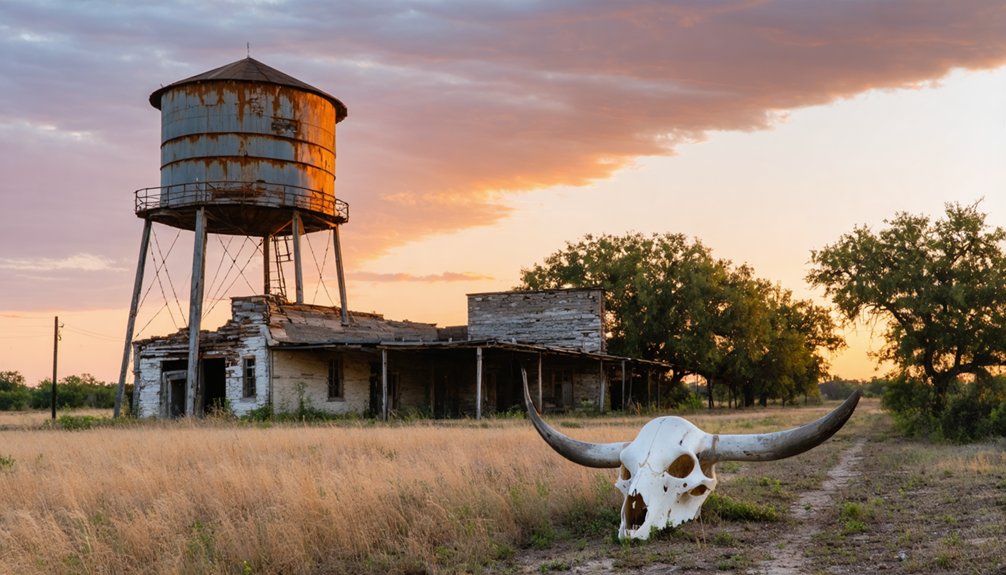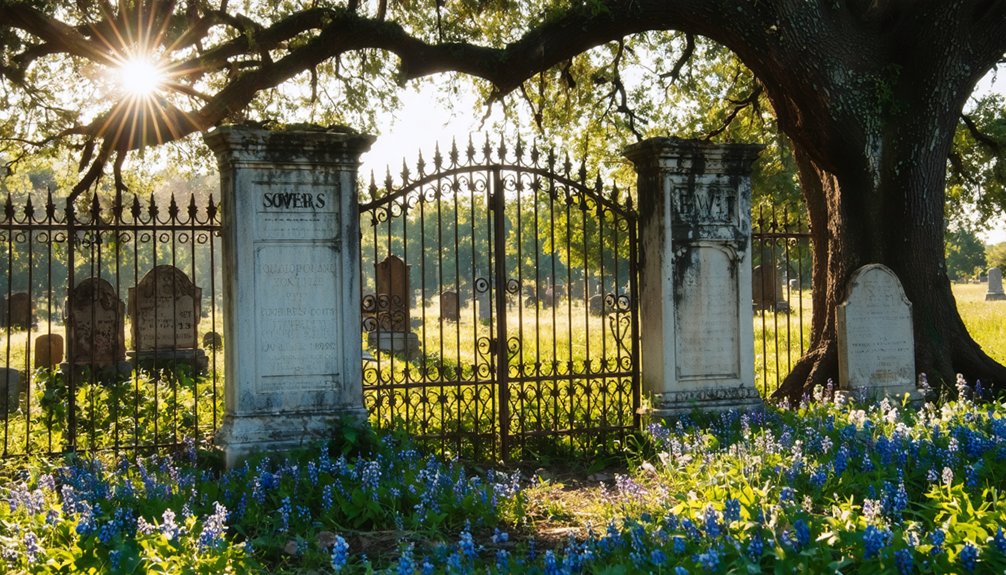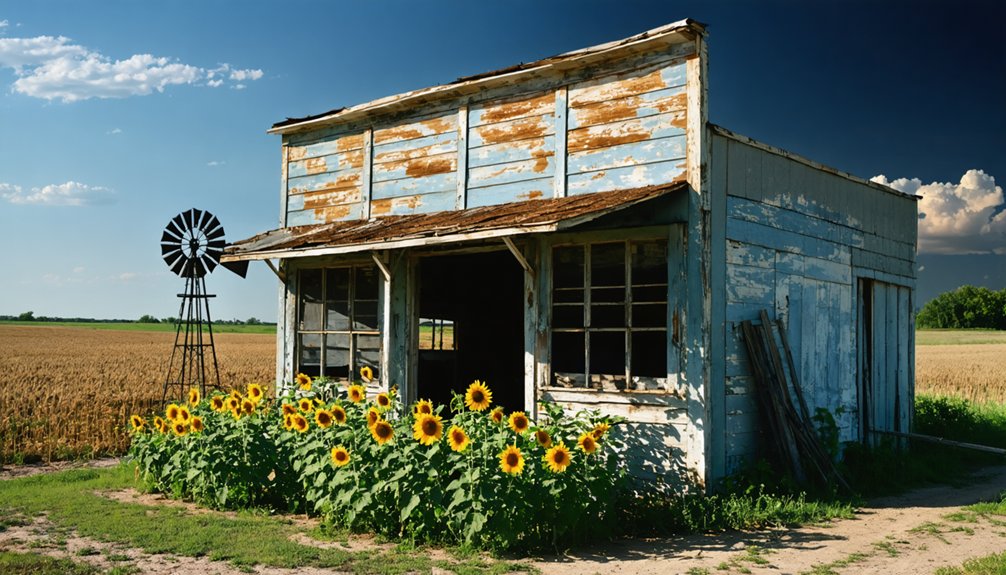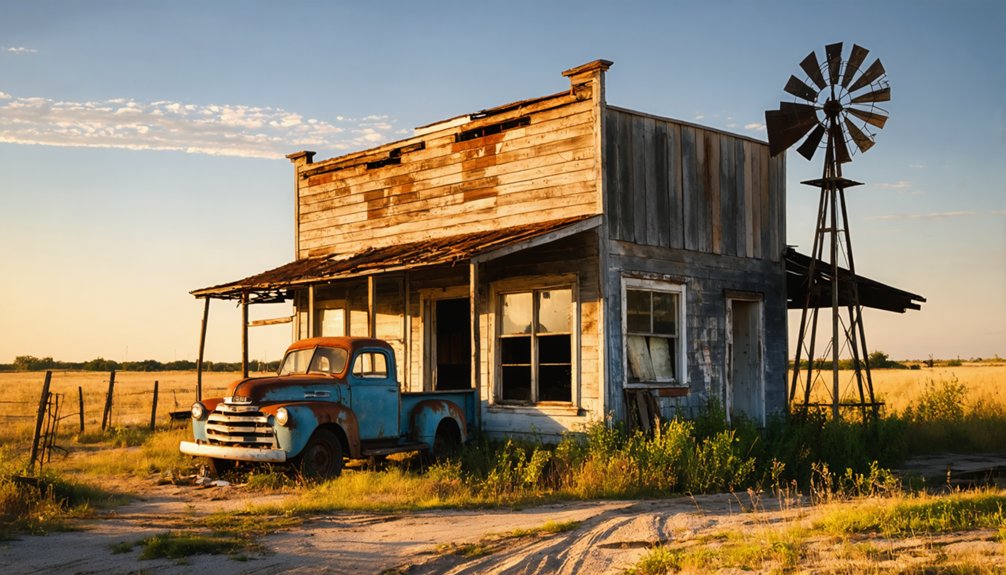You’ll find Sowers’ origins in 1856 when Edmund and Freelove Sowers claimed 32 acres near present-day Irving, Texas. The settlement grew around their two-story home, store, and post office, peaking at 121 residents. As a crucial transport hub between Dallas and Grapevine, Sowers thrived until urban expansion in the mid-1900s transformed the rural community. While most original structures have vanished, the historic Sowers Cemetery still marks this pioneer settlement’s legacy.
Key Takeaways
- Sowers was a 19th-century Texas settlement that declined from a peak population of 121 residents after the Great Depression.
- The community’s post office closed in 1905 due to Dallas’s expansion, marking the beginning of its decline into a ghost town.
- Original structures including Sowers Store, the schoolhouse, and other historic buildings have disappeared due to urban development.
- The Sowers School consolidation with Irving in 1955 marked a significant loss of community identity and independence.
- The former rural hamlet transformed into a suburban area, with only the cemetery remaining as evidence of the original settlement.
Origins and Early Settlement
When Edmund D. and Freelove Sowers arrived in Texas from Illinois in 1856, they claimed 32 acres within the Parsons headright in what’s now western Irving.
They settled near present-day Pioneer Road and Beltline Roads, where pioneer challenges awaited them on the western edge of Dallas County. As a blacksmith, Edmund tackled early agriculture by clearing and fencing his land while building a two-story house over three years. Like other frontier settlements that began as river crossing points, the Sowers family chose their location strategically. They established a local post office in their store, with Edmund serving as postmaster.
The area’s frontier status meant few neighbors and slow development, but the Sowers family persevered. Their settlement, part of the Peters Colony land grant program, required hauling lumber and supplies over long distances.
Despite the rural isolation, they established themselves as essential community founders, setting the foundation for what would become the town of Sowers.
The Sowers Family Legacy
Through their dedication and entrepreneurial spirit, the Sowers family left an indelible mark on western Dallas County that extended far beyond their original 32-acre settlement.
Edmund Sowers (1826-1909) and his wife Freelove Thompson Sowers (1833-1901) established themselves as community pillars through their numerous Sowers contributions, including Edmund’s role as postmaster from 1883 to 1890.
The family’s commitment to growth led Edmund to donate land for a cemetery in the 1870s, which became a centerpiece of community life alongside a nearby school and church. The property was officially deeded in 1874 when Edmund D. Sowers donated the land for cemetery purposes.
Family traditions flourished as they sponsored annual picnics and dances, fostering strong social bonds.
Their store and post office served as the town’s hub, while their involvement in trades like blacksmithing helped sustain the local economy.
The town reached its peak when the population grew to 121 residents before the Great Depression drastically changed the community’s trajectory.
A Strategic Location in Dallas County
Sowers’ location between Dallas and Grapevine made it a natural transportation hub, where you’d find early settlers stopping to resupply at Edmund Sowers’ store while traveling the mail route established in 1883.
The early settlers utilized direct navigation routes between communities, following the principles that would later guide modern transportation planning. You’ll notice the town’s positioning near key early roads helped connect rural communities to Dallas, facilitating the exchange of goods and mail throughout northwestern Dallas County. The settlement’s classification as a distinct entity within historical records helped preserve its importance in Dallas County’s development.
The area’s fertile soil and relatively flat terrain, typical of North Texas plains, supported the farming families who formed the backbone of this small but essential community.
Transportation Hub Benefits
As a strategic settlement within present-day Irving’s city limits, Sowers capitalized on its prime location near Dallas’s urban core to become an essential transportation hub in the late 1800s.
Similar to ancient civilizations that relied on manual sowing, the transportation evolution of this small community shaped its economic implications, transforming it from a rural outpost into a significant connection point for commerce and communication. The community’s proximity to Portland Cement Plant operations enhanced its industrial significance in the early 1900s.
- Served as a pivotal waypoint for stagecoaches and freight transport between Dallas and western territories
- Facilitated the movement of lime from La Reunion to Dallas’s growing construction industry
- Provided market access for local farmers through its store and post office
- Connected emerging suburbs through a network of trails that later evolved into modern roadways
The community’s strategic position near major transport corridors supported its role in Dallas County’s westward expansion, though later urban growth would eventually absorb its independent identity.
Natural Resources Advantage
Located 11 miles northwest of Dallas, the settlement of Sowers benefited from an abundance of natural resources that made it an attractive destination for early pioneers.
You’d find rich, fertile soil perfect for farming, with gently rolling terrain that supported diverse agricultural activities. The land’s natural drainage and elevation of 500-600 feet provided ideal conditions for sustainable crop cultivation and livestock grazing.
The area’s resource sustainability was enhanced by nearby water sources and accessible timber from Dallas County forests. Early settlers like Edmund Sowers implemented smart land management practices, clearing fields and establishing fenced areas to protect their investments. Modern mapping tools pinpoint this historic area using UTM coordinates 14S for precise geographical reference.
The temperate climate and adequate rainfall allowed for year-round farming cycles, while native grasses and woodlands provided essential materials for fuel, construction, and forage.
Life in Rural Sowers
Life in rural Sowers centered around farming and blacksmithing during the late 1800s, with many southerners settling the area after the Civil War.
The community’s economic activities thrived around a central store built in 1877, which became a hub for trade and social interaction. You’d find the spirit of freedom and independence in the way residents organized their lives, from working the fertile soil to participating in community gatherings. Ed Sowers’ store also served as the community’s first post office in 1881.
- Annual Fourth of July picnics and dances brought everyone together
- The first school, built in 1881, served as an educational and social center
- Families like the Sowers often hosted community events and celebrations
- Various professionals, including doctors and druggists, provided essential services
This tight-knit rural community maintained its independent character until annexation by Irving in the 1950s.
Establishment of Community Landmarks

You’ll find the original Sowers store site marked the heart of this rural community, serving as both a gathering place and trading post for early settlers.
The historic post office operated from within various local businesses until establishing its permanent location in 1949, providing essential communication services to area residents.
Local families contributed land for both the school and church grounds, ensuring their children had dedicated spaces for education and worship before the town’s absorption into Irving.
School and Church Grounds
As Sowers began taking shape as a community, Edmund Sowers made a pivotal contribution in 1874 by donating land specifically for a school, church, and cemetery.
The school’s significance grew when the first one-room schoolhouse was built in 1881, evolving into a two-story structure by 1903 that served multiple community needs.
- The lower floor functioned as both school and church, uniting education and worship
- The upper floor hosted Woodmen of the World lodge meetings
- You’d find the church community gathering regularly for services and social events
The building remained central to local life until fire destroyed it in 1960.
The school and church grounds became the heart of Sowers, fostering both learning and spiritual growth until the school district merged with Irving ISD in 1956.
Historic Post Office Location
While Sowers Store served as an informal mail stop on the Dallas-to-Birdville route before the Civil War, the community’s official post office wasn’t established until 1881.
The post office significance grew as Edmund Sowers resumed postal operations after the war, serving as the first postmaster before passing duties to H.N. Lucas.
You’ll find the mail route evolution reflected changing regional dynamics, as service shifted from the Dallas-to-Birdville path to a Dallas-to-Grapevine route that included stops in Sowers and Estelle.
The post office became an essential community landmark, helping Sowers grow to 121 residents by 1884.
However, Dallas’s expansion eventually made the local post office unnecessary, leading to its closure in 1905 and contributing to the settlement’s gradual decline.
Original Sowers Store Site
The original Sowers Store, opened by Edie Sowers in the late 1840s, marked the beginning of this Northwest Dallas community.
Located at what’s now 3207 W. Pioneer Dr. in Irving, the store quickly became the heart of local commerce and community gatherings. As settlers flocked to the area, the population grew to 75 residents by 1884, and the site evolved into a thriving rural hub.
- The store served as the community’s first mail distribution point before the 1881 post office.
- Essential services like medical care and blacksmith work emerged around the store.
- A church and school were established nearby, creating a complete community center.
- The store’s success sparked development of other local businesses until Dallas’s growth changed the landscape.
The Historic Sowers Cemetery

Located on Pioneer Road in west Dallas County, Sowers Cemetery stands as Irving’s oldest and largest community burial ground. The cemetery’s history began in 1868 with the burial of an unnamed woman and child on Sevier Smalley’s land.
Edmund D. Sowers formalized the site in 1874 by donating an acre for cemetery, school, and church use.
You’ll find burial customs reflected in the mix of simple stones and elaborate monuments, including the impressive Sowers family memorial funded through their land sale.
The cemetery traces its pioneer roots to the Peters Colony era, predating Irving’s founding by decades.
Today, the Sowers Cemetery Association maintains this historic site, which includes sections known as Beulahland Memorial Park and Sunset Memorial Park, preserving the legacy of early Texas settlers.
Urbanization and Community Transformation
During the mid-twentieth century, Sowers underwent a dramatic transformation from rural hamlet to suburban landscape as Irving’s expanding borders absorbed the community in two stages between 1954 and 1956. The urban growth pattern reflected the broader changes sweeping across Dallas County, as small rural communities gave way to suburban development.
- By the 1880s, Sowers thrived with 75 residents, two steam gristmill-cotton gins, and essential services.
- The 1955 consolidation of Sowers School with Irving marked a turning point in community identity.
- Original structures and businesses gradually disappeared as Irving’s infrastructure expanded.
- The economic base shifted from agriculture to diverse urban employment opportunities.
This transformation mirrors the story of many Texas communities that vanished as metropolitan areas expanded, leaving only their cemeteries to mark their existence.
Preserving a Pioneer Settlement’s Memory

While physical traces of Sowers have largely disappeared into Irving’s suburban landscape, dedicated preservation efforts guarantee this pioneer settlement’s legacy lives on through multiple channels.
The Sowers Cemetery stands as the last tangible link to this pioneer community, with ongoing historical preservation ensuring its tombstones and grounds remain protected from urban development.
You’ll find the settlement’s story preserved through various means: archived newspapers from the Texas Ghost Town Collection, historical markers that honor the founding families, and documented records from the old Sowers School.
Community engagement brings this heritage to life through educational tours, ceremonies, and historical reenactments at the cemetery. Local historical societies and volunteers continue to maintain these essential connections to Sowers’ past, while school programs help pass this pioneer legacy to new generations.
Frequently Asked Questions
What Happened to the Original Sowers Store Building?
You won’t find the original Sowers store building today – it’s vanished from history. After William Haley’s ownership ended in the early 1900s, the structure likely deteriorated and was lost to time.
How Many Students Attended the Sowers School at Its Peak?
Though Sowers history fills volumes, you’d find the school legacy shows no exact peak enrollment records. Based on the tiny rural community’s size, you’re likely looking at 20-30 students maximum.
Were There Any Notable Crimes or Incidents in Sowers?
You won’t find any documented crimes or unsolved mysteries in the historical record. While local legends might exist, the community was particularly peaceful until its eventual absorption into Irving.
What Crops Were Primarily Grown by Sowers Farmers?
You’d find cotton farming dominated Sowers’ agricultural landscape, followed by corn production. Farmers also grew wheat and oats for livestock, plus vegetables and fruits for local consumption.
Did Any Famous People Ever Visit or Live in Sowers?
Like a blank guestbook left untouched, you won’t find evidence of any famous visitors or historical figures who lived in Sowers. Even Bonnie and Clyde only passed near the outskirts.
References
- https://kids.kiddle.co/Sowers
- https://www.sowerscemetery.com/our-story
- http://texasghosttowns.blogspot.com/2011/11/la-reunion-dallas-county-august.html
- https://www.wikiwand.com/en/map/Sowers
- https://atlas.thc.texas.gov/Details/5507013736
- https://www.hmdb.org/m.asp?m=150477
- https://www.texasescapes.com/CentralTexasTownsNorth/Sowers-Texas.htm
- https://www.tshaonline.org/handbook/entries/sowers-tx
- https://mix941kmxj.com/the-strange-sad-story-of-a-texas-ghost-town-youll-never-visit/
- https://dallaspioneer.org/sowers-cemetery/



